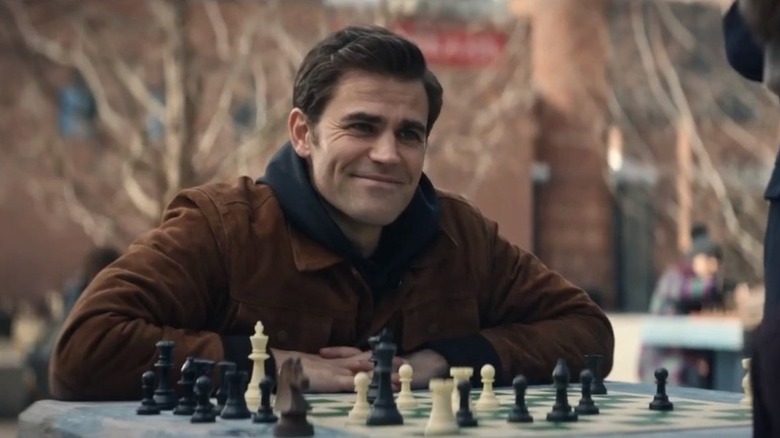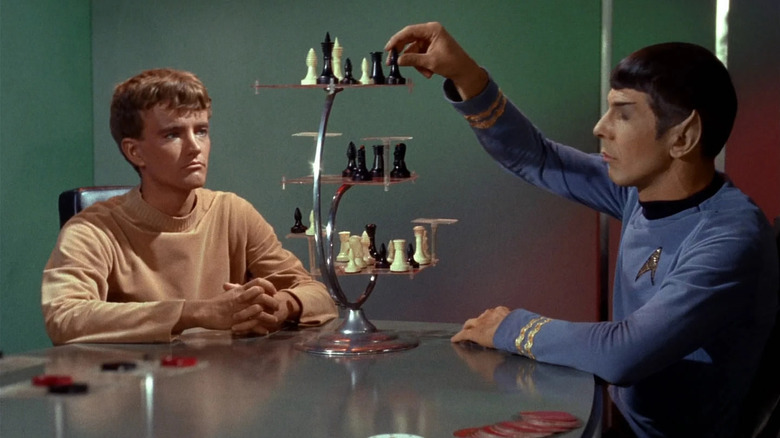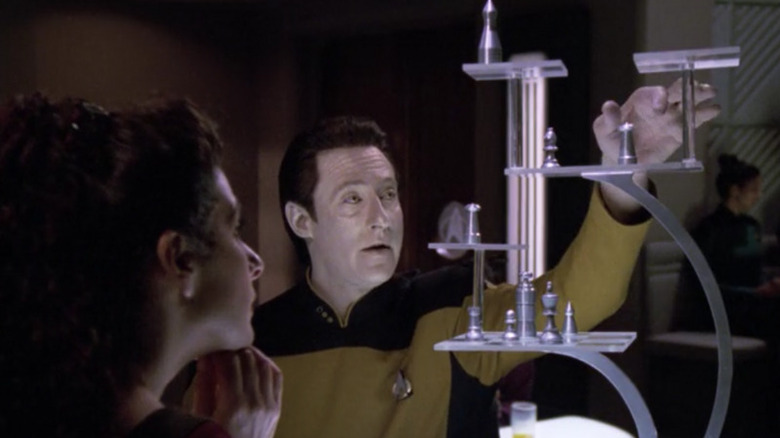Star Trek: Strange New Worlds Season 2's Silly Chess Sequence Deserves A Closer Look
In the newest episode of "Star Trek: Strange New Worlds," called "Tomorrow and Tomorrow and Tomorrow," Lieutenant La'an Noonien-Singh (Christina Chong) and an alternate universe version of Captain Kirk (Paul Wesley) find themselves stranded in 21st-century Toronto. Having come from a post-capitalist future, the two have no money, nor anything of value to exchange for food and clothing. In order to hustle up a few loonies, Kirk sits in a park and challenges any takers to games of chess. The foolhardy Canadians each lose in turn, and it's not long before Kirk and La'an have the capital they need to traverse Earth's present.
As has been established throughout "Star Trek," chess is a game that will survive into the future, largely unchanged. It's easy to see why: chess is perhaps a perfect game. It's easy to set up, easy to visualize, and easy to learn, but massively difficult to master. "Star Trek" posits, however, that chess would eventually evolve into a 3D version with five stacked playing fields instead of just one. Old-school chess was played on an 8x8 grid. "Star Trek" chess would have three 4x4 grids and four 2x2 grids. It's all very complicated.
Kirk mentions that he learned how to play 2D chess as a boy before stepping up to the "real" version. For him, 2D chess is a child's game, hence his skill in creaming Canadians.
Of course, thinking about chess and "Star Trek" might lead one to ask some pertinent questions about 3D chess, including wondering how silly the concept might be. It turns out that 3D chess, thanks to some enterprising nerds, is a real game that you can purchase and learn. You, too, can step beyond the children's game and into the future.
3D chess
The first time audiences saw 3D chess was in the "Star Trek" episode "Charlie X" (September 15, 1966), the second episode of the series. In that episode, Robert Walker played an impetuous teen who happened to be blessed with godlike supernatural powers. Spock (Leonard Nimoy) skunked Charlie at chess — a game he wasn't familiar with — and Charlie, in his anger, melted the pieces with his mind. The chess board was mounted on a fancy, coiled base, and traditional chess pieces were moved across five planes of action. The 3D chess board was also featured in the original "Star Trek" pilot, "The Cage," but the public didn't see that episode until the 1980s.
If one looks into gaming history, 3D versions of chess were being developed as early as the 1850s. A Russian game master named Lionel Kieseritzky invented a game he called Kubikschach which was played on eight levels of 8x8 grids. It was, essentially, a chess cube. Later, in 1907, a German game maker named Ferdinand Maack simplified the cube into a chess game he called Raumschach, which was played on five levels of 5x5 grids. That, it seems, might be easier to visualize.
When it came to "Star Trek," it seemed that the show's production designers weren't trying to pioneer a new game, but merely required board games that looked futuristic. One might also notice in "Charlie X" that there is a 3D version of checkers as well. The chess pieces on "Star Trek" were taken from an "arty" chessboard designed by Peter Ganine in 1961. It wouldn't be until 1976 that a forward-thinking Trekkie named Andrew Bartmess would think to develop actual rules for 3D chess. If one is resourceful, one can find the original rulebook online.
The rules
3D chess lasted into the days of "Star Trek: The Next Generation," and there is a notorious scene in the episode "Conundrum" (February 10, 1992) wherein Counselor Troi (Marina Sirtis) defeats the android Data (Brent Spiner) at chess. She explains that chess is not just a game of ploys and gambits, but a game of intuition. Hard disagree, counselor. Chess is a game of ploys and gambits.
Trekkies would sometimes make 3D chess sets at home, as the game didn't seem to have enough cultural traction to warrant a mass-marketed edition. It wouldn't be until 1994 that the Franklin Mint, the same souvenir company that made the infamous "Star Trek" collectors plates, would manufacture a fragile, high-end 3D chess set for Trekkies with several hundred dollars to blow. The boards were made of glass, the metal base was heavy and expensive, and the pieces were plated in actual gold and silver. It was a highly coveted knickknack among collectors. One can still find the Franklin Mint editions online, but the price has only gone up.
These days, a more affordable version (well, a $175 version) can be purchased through the Star Trek website. One might find a complex and difficult-to-learn game just waiting for them. It turns out that the pieces travel across various 3D planes, but also that several of the planes themselves can be moved and reoriented. It takes a strong mind and a great sense of spatial continuity to master a game like 3D chess in real life. After playing it for a while, 2D chess does indeed feel like a child's game.
As someone who still cannot operate a Rubik's cube, I am still in the process of learning 3D chess.


